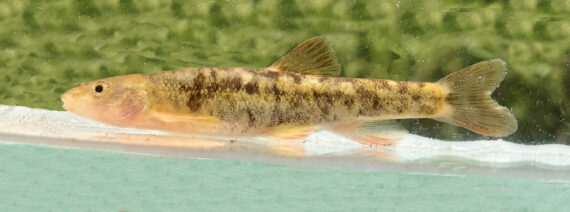Loach Minnow, Rhinichthys cobitis
Note: This Species is currently considered to be ENDANGERED and if encountered should be handled accordingly.

 Loach Minnow, Rhinichthys cobitis. A pair of fish collected from the Lower Blue River in Southeast Arizona, June 2020, photographed, and quickly returned to its native environment unharmed.
Loach Minnow, Rhinichthys cobitis. A pair of fish collected from the Lower Blue River in Southeast Arizona, June 2020, photographed, and quickly returned to its native environment unharmed.
Note: In 2012 the Loach Minnow was placed on the Federal Endangered List by the United States Department of the Interiors Fish and Wildlife Service covering the known populations in Arizona and New Mexico. The fish is included in this www site to provide education to recreational anglers in case they encounter this species in the wild and can treat the catch appropriately, i.e., immediately returning to its native environment unharmed. It is also included due the availability of quality photographs taken by one of my readership who encountered the fish in the wild and asked for my help with the identification.
The Loach Minnow, Rhinichthys cobitis, is a member of the Carps and Minnows or Cyprinidae Family, and is known in Mexico as carpita locha. Globally, there are eight species in the genus is only two species in the genus Rhinichthys and it is found in Mexico’s freshwater systems.
The Loach Minnow has a small, elongated body that is flattened ventrally. They have an olive background color that is highly blotched with dark pigments. They have off-white spots before and behind the dorsal fin and on the lower sides at the base of the caudal fin and most have black spot at the base of the caudal fin. Breeding males have vivid red-orange markings on the bases of the fins, body and lower head. Breeding females have yellow colorations on their fins and lower body. Their head has a pointed snout and a slightly subterminal mouth and large eyes. Their anal fin has 7 rays and their dorsal fin has 8 rays. They do not have scales.
The Loach Minnow is a small freshwater demersal species that is found in turbulent, rocky riffles or often vegetated mainstream rivers with moderate to swift currents and gravel substrate. They reach a maximum of 6.5 cm (2.6 inches) in length. They are opportunistic benthic insectivores consuming larval of flying insects and aquatic insects. Reproduction is oviparous with each female producing one or two broods of 150 to 1,200 eggs per year with the deposited on the bottom of flattened rocks. They have life spans of up to five years. The Loach Minnow is poorly studied with very limited information available about their lifestyle and behavioral patterns including specific details on age, growth, longevity, movement patterns, diet, habitat use, and reproduction.
The Loach Minnow historically common and endemic to the upper San Pedro and the Gila Rivers in Sonora at elevations below 2,200 m (7,200 feet). However, these water bodies have undergone significant changes in recent years and there are reports that the Loach Minnow is now extinct in Mexico.
The Loach Minnow is most likely confused with the Speckled Dace, Rhinichthys osculus (lacks white spotting on the origin and insertion of the dorsal fin).
From a conservation perspective the Loach Minnow is currently considered to be ENDANGERED with populations and range declines documented to be up to 90% in recent years that are attributed to the removal of water from their habitats, steam impoundment, domestic livestock grazing, mining, road construction, pollution and the introduction of non-native species including Channel Catfish, Green Sunfish, Rainbow Trout, Red Shiner, and Smallmouth Bass. They are very small in stature and of limited interest to most. They are, however, a major focus of conservationists in Arizona and New Mexico.